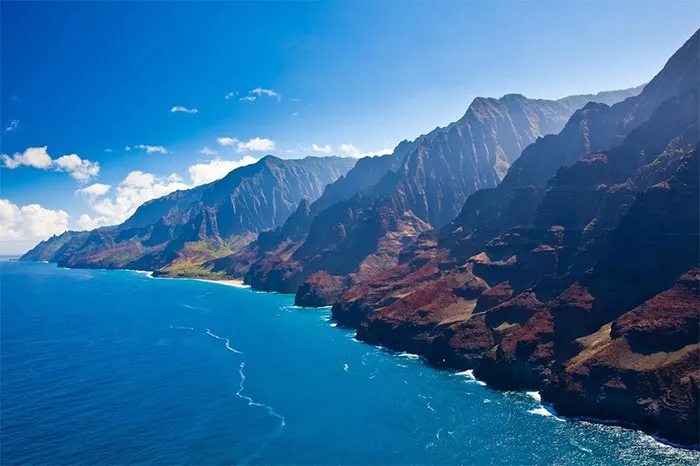Discover the Majesty of Nature Through 20 Lesser-Known Wonders of the World
Mysterious Wonders of the World
- Black Sand Beaches, Iceland
- Lake Natron, Tanzania
- Antelope Canyon, USA
- Na Pali Coast, Hawaii
- Great Blue Hole, Belize
- Yellowstone National Park, USA
- Ha Long Bay, Vietnam
- Pamukkale, Turkey
- Iguazu Falls, Argentina/Brazil
- Salar de Uyuni, Bolivia
- Cano Cristales River, Colombia
- Chocolate Hills, Philippines
- Mount Zao, Japan
- Waitomo Glowworm Caves, New Zealand
- Lake Baikal, Russia
- Zhangye National Geopark, China
- Lake Hillier, Australia
- Spotted Lake, Canada
- Eternal Flame Falls, USA
- Danakil Depression, Ethiopia
While landmarks like the Great Wall of China and the Taj Mahal are globally renowned, these extraordinary yet lesser-known destinations boast unique natural beauty worth exploring.
1. Black Sand Beaches, Iceland
The black sand beaches of Iceland resemble a surreal setting from a fantasy film. The dark-colored sand originates from volcanic eruptions in the region.
When molten lava meets water, it cools rapidly and solidifies, breaking into fragments. Over time, these fragments erode into finer grains, forming the distinctive black sand beaches.

2. Lake Natron, Tanzania
Lake Natron, a unique saline lake in northern Tanzania near the Kenyan border, is one of nature’s most fascinating yet lesser-known wonders. The lake is famous for its striking red hue, caused by high concentrations of sodium carbonate and other alkaline salts. These minerals come from hot springs and subterranean sources in volcanic regions.
Its extreme alkalinity and salinity make it an inhospitable environment for most life forms. However, halophilic microorganisms and red algae thrive, giving the water its vibrant red and pink tones.

3. Antelope Canyon, USA
Located in the Navajo Nation near Page, Arizona, Antelope Canyon is famous for its intricate geological formations and stunning colors.
The canyon’s narrow, winding pathways have been sculpted over centuries by wind and water erosion. Its smooth, curving walls display mesmerizing patterns. Guided tours allow visitors to venture deep into the canyon, witnessing an extraordinary play of light and shadow that enhances its dramatic hues.

4. Na Pali Coast, Hawaii
One of the most photographed locations in Hawaii, the Na Pali Coast features lush, rugged cliffs rising above sparkling turquoise waters, creating a breathtaking view.
Many visitors recognize this landscape from blockbuster films like Jurassic Park. While boat tours offer an up-close view, an aerial tour provides a panoramic glimpse of Na Pali’s majestic beauty.

5. Great Blue Hole, Belize
A natural marvel off the coast of Belize in Central America, the Great Blue Hole is one of the world’s largest and deepest underwater sinkholes, measuring over 300 meters in diameter and 120 meters deep.
From above, this circular abyss contrasts vividly with the surrounding turquoise waters, creating an entrancing visual. It formed over 10,000 years ago during the Ice Age when sea levels were significantly lower.

6. Yellowstone National Park, USA
Established in 1872, Yellowstone is the world's first national park. Early reports of its geothermal wonders were met with skepticism.
The park is home to geysers, hot springs, mud pots, and steam vents, including Old Faithful, which erupts regularly, shooting water over 50 meters into the air.

7. Ha Long Bay, Vietnam
A UNESCO World Heritage Site, Ha Long Bay is among Vietnam’s most visited destinations. It features over 1,600 limestone islands and islets, forming a breathtaking seascape.
The bay’s emerald waters make it ideal for boat tours. The best time to visit is from October to April, when the weather is cooler.

8. Pamukkale, Turkey
Known as the “Cotton Castle,” Pamukkale is a UNESCO-listed wonder in southwestern Turkey. Over thousands of years, mineral-rich hot springs have deposited calcium carbonate, forming dazzling white terraces.
Visitors can walk barefoot along these terraces, enjoying the warm, mineral-rich waters known for their healing properties.

9. Iguazu Falls, Argentina/Brazil
Straddling the border between Argentina and Brazil, Iguazu Falls is the world’s largest waterfall system, consisting of 275 cascades.
The most famous section, Devil’s Throat, is a U-shaped waterfall over 80 meters high, surrounded by lush rainforest and echoing with the roar of crashing water.

10. Salar de Uyuni, Bolivia
The world’s largest salt flat, Salar de Uyuni, covers over 10,000 square kilometers in southwest Bolivia. Formed by the evaporation of prehistoric lakes, it creates a vast, surreal landscape.
During the rainy season, the flat transforms into a giant mirror, reflecting the sky in a stunning optical illusion.

These natural wonders, though lesser known, rival the world’s most famous landmarks in beauty and uniqueness. Whether you’re an adventurer or a nature lover, these destinations promise unforgettable experiences.

